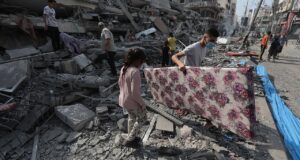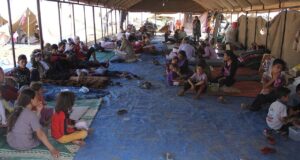March 14, 2015
By Rebecka Buchanan – Research Assistant
In January 2015 it was announced that Palestine was to accede to the Rome Statute of the International Criminal Court, which was swiftly followed by announcement from the ICC Prosecutor that she was opening a preliminary examination into the conflict last summer. Before any case can come before the Court, it must be determined what type of conflict exists as this has direct implications for the range of war crimes that can be prosecuted. This move towards international justice opens the possibility that it may also decide in the future to award jurisdiction over the conflict to the International Court of Justice. The ICJ has competence to look at whether the law against war (jus ad bellum) has been breached, which will be considered in the later half of this article.
Jus in Bello
International Humanitarian Law is the body of law governing armed conflicts, thus the triggering of IHL is dependent on a situation being defined as an armed conflict.[1] The International Criminal Tribunal for the Former Yugoslavia (ICTY) has determined that an armed conflict exists ‘whenever there is resort to armed force between States or protracted armed violence between governmental authorities and organised armed groups or between such groups within a State’.[2] Therefore practice confirms that an international armed conflict (IAC) occurs between two or more States resorting to armed force, while a non-international armed conflict (NIAC) exists when a State and organised armed group resort to protracted armed violence. Whilst IHL is a distinction branch of law in comparison to International Criminal Law (the area of law that concerns the ICC), the classification of a conflict has direct consequences for the criminal law that is applicable during it. The Rome Statute outlines a wider range of war crimes during an international armed conflict as opposed to during a non-international conflict, so it is important to classify the conflict under the jus in bello in order to determine which criminal law applies.
The legal classification of the conflict between Israeli armed forces and Palestinian militants is complex. Not only are Hamas non-State actors, the armed conflict between Hamas and Israeli armed forces took place on Palestinian territory (Gaza), causing difficulty in determining the law of armed conflict governing hostilities. The classification of the Gaza conflict, as IAC or NIAC, is crucial to determining the laws of armed conflict that apply. Although many rules of IAC, specifically fundamental principles of IHL, are now applicable in NIAC, under customary international law, undoubtedly differences remain. The the law of IAC, codified in the Geneva Conventions of 1949 and Additional Protocol I of 1977, provides far greater civilian protections and places greater legal obligations on parties to the conflict than the law of NIAC, codified in Common Article 3 of the Geneva Conventions and Additional Protocol II of 1977.
Occupation
It is disputed whether the Gaza Strip is still considered as Occupied Palestinian Territory, however Israel asserts that it removed military bases in 2005 and that Gaza is no longer under occupied territory.[3] The relevance of occupation is that the law of occupation – contained in the Hague Regulations of 1907, the Fourth Geneva Convention of 1949, and Additional Protocol I of 1977 – will apply. Under IHL there is occupation when a State exercises an unconsented-to effective control over a territory, and according to Article 42 of The Hague Regulations occupation exists where a territory is placed under the authority of the hostile army.[4] Therefore, if the Gaza Strip is still under Israeli occupation, the rules of IHL relevant to occupation governed the Gaza conflict.
IAC
As mentioned, IACs oppose two or more States. Therefore to engage the rules of IAC, Palestine must be considered as a State to characterise the Gaza conflict as an IAC between Palestine and Israel. If Palestine is considered as a State, the rules of IAC may be engaged through the actions of Hamas being attributed to the State of Palestine, or Palestine rejecting Israel’s use of force on its territory.
Prior to April, this year, Palestine’s authority was shared. Hamas has governed the Gaza Strip since its victory in the Palestinian Legislative Council elections in 2006,[5] while the Palestine Authority has governed the unoccupied areas of West Bank. However, in April, the Palestine Authority and Hamas agreed to form a shared government. The first meeting of the Palestinian Unity Government convened in October to discuss the rebuilding of Gaza,[6] therefore it is questionable whether the actions of Hamas during the Gaza conflict can be attributed to Palestine. To engage the responsibility of Palestine it must be shown that Palestine had effective control[7] over the conduct of Hamas that directly contributed to hostilities with Israel.
Where the actions of Hamas could be attributed to Palestine, the conflict can be characterised as an IAC. However where the actions of Hamas could not be attributed to Palestine the conflict would be characterised as a NIAC.
NIAC
Traditionally NIACs opposed State and non-State parties within the territory of the State party, so called internal armed conflicts, however increasingly armed conflicts between State and non-State parties are taking place outside the territory of the State party.[8] Such conflicts are referred to as cross-border NIACs, and arguably lie somewhere between IACs and NIACs. Cross-border conflicts share common features with both IACs and NIACs: both IACs and cross-border conflicts involve a cross-border element with hostilities occurring on more than one territory and parties to the conflict operating from different States; while NIACs and cross-border conflicts both involve hostilities between State armed forces and an organised armed group.[9]
It is the nature of the parties to the conflict, rather than the cross-border element, that constitutes the decisive factor in characterising the conflict as international or non-international. Thus if the parties engaged in hostilities are State and organised armed group, the rules of NIAC will be triggered, regardless of whether international borders are crossed. Therefore, where the actions of Hamas cannot be attributed to Palestine, the conflict between Hamas and Israel may be considered as a cross-border NIAC.
Alternatively, there could have been a parallel IAC and NIAC occurring in Gaza. Where the actions of Hamas could not be attributed to the State of Palestine the conflict between Hamas and Israeli armed forces would remain governed under the law of NIAC. However Palestine did not consent to the use of force by Israel in Gaza, triggering the application of the law of IAC as the extraterritorial use of force by Israel on Palestinian territory can be regarded as a prohibited use of force.[10] The aim of this ‘double classification’ approach is to take into consideration that the acts of the organised armed group cannot be attributed to the territorial State, thus there must be two separate conflicts occurring simultaneously.[11]
Jus ad Bellum
The jus ad bellum is the branch of law that defines the legitimate reasons a State may engage in war.[12] The principle legal source of the jus ad bellum derives from Article 2(4) of the United Nations (UN) Charter prohibiting the threat or use of force against any State, and Article 51 providing an inherent right of self-defence against an armed attack. The primary court for determining whether breaches of the jus ad bellum have occurred is the International Court of Justice, which Palestine is not a member of. However, with a move towards international justice, Palestine may in the future decide to become a member of the ICJ if it becomes a member of the UN (the ICJ statute is annexed to the UN Charter) and award the court jurisdiction over its conflicts. Therefore, it is important to try and identify whether the jus ad bellum was breached during the conflict between Israel and Palestine last summer.
Violence between Israeli soldiers and Palestinian militants, over the summer, spiralled into an Israeli ground invasion of the Gaza Strip following the alleged murder of three Israeli students by members of Hamas.[13] Israeli extremists later retaliated with revenge killings and Israel launched a ground invasion into Gaza following rockets launched by Hamas. Although international discussion has primarily concentrated on breaches of IHL by both parties to the conflict, it is necessary to consider whether there have been breaches of the jus ad bellum. The key issue in determining whether there have been breaches of the jus ad bellum is whether Israel was lawfully exercising its right of self-defence.
Palestinian Statehood
The statehood of Palestine is contested, particularly because of Palestine’s lack of defined territory, however the UN accorded Palestine non-member observer State status in 2012, de facto recognising Palestine as a State.[14] This means that a majority of the UN General Assembly recognise Palestine as a State and Palestine could join the ICC as a result. However there remain many States that contest Palestine’s statehood, particularly Israel, therefore it cannot be said that Palestine is universally accepted as a State. To engage the prohibition on the use of force there must be a use of force by one State against another State. Therefore, for the purposes of analysing the jus ad bellum Palestine will be considered as a State.
Article 2(4)
The prohibition on the threat or use of force is a cornerstone of international law, accepted as a norm of customary international law and jus cogens. There is no doubt that Israel used force in Gaza by launching Operation Protective Edge aimed at stopping Hamas rocket attacks and destroying Hamas tunnels. An armed conflict ensued between the parties, with more than one thousand civilians killed in Gaza.[15]
Self-Defence
The primary exception to the prohibition on the use of force is self-defence, enshrined in Article 51 of the UN Charter, legalising the resort to force if such actions are in response to an armed attack, are necessary and proportionate, and are reported to the UN Security Council.[16]
Armed Attack
Hamas admitted to firing rockets into Israel in July,[17] following which Israel launched ground operations, allegedly acting in self-defence. It is generally accepted that an armed attack must comprise military actions, however the meaning of ‘armed attack’ was clarified by the International Court of Justice (ICJ) in Nicaragua when the Court held that ‘the sending by or on behalf of a State of armed bands, groups, irregular or mercenaries, which carry out acts of armed forces against another State of such gravity as to amount to’ an actual armed attack.[18] Therefore actions taken by Hamas, on behalf of Palestine, could be considered as an armed attack to which Israel could respond in self-defence.
Although the launching of rockets may be attributed to Hamas, and Hamas govern Gaza, Gaza remains part of Palestinian territory. It is debatable, however, whether Hamas rocket fires can be attributed to the State of Palestine. Where such fires cannot be attributed to Palestine, no State can be held responsible for the fires. The law relating to self-defence against a non-State actor remains unsettled. The ICJ confirmed that the right of self-defence, contained in Article 51 UN Charter, applies only between States, and uses of force by organised armed groups may only be seen as an armed attack where such actions can be attributed to a State.[19] However, in Congo v Uganda[20] the Court left open the possibility that contemporary international law provides for a right of self-defence against large-scale attacks of irregular force. Therefore, if the actions of Hamas cannot be attributed to Palestine, Israel may still have a right of self-defence against Hamas.
Proportionality
The most important issue in determining whether Israel’s use of force against Palestine was legal is determining whether the use of force, and degree of force, used was necessary to respond to the armed attack and proportionate to the threat posed by that attack.[21] Therefore, it must be shown that Israel’s ground invasion into Gaza was both necessary and proportionate to the respond to rockets fired by Hamas.
In Nicaragua the ICJ noted that there is a ‘specific rule whereby self-defence would warrant only measures which are proportional to the armed attack and necessary to respond to it’.[22] For Israel’s actions to be considered as proportionate, it must be shown that Israel’s ground invasion into Gaza was necessary to respond to Hamas rocket fires, and proportionate to the threat posed by Hamas. The requirement of proportionality is forward-looking; therefore whether Israel’s actions are considered as proportionate depends on the goal in which Israel was wishing to achieve when it launched its ground invasion into Gaza. Israel’s actions would be considered as necessary if it can be shown that Israel could not have achieved its goals without such resort to force, and so long as the degree of force used did not exceed what was reasonably required for that purpose.[23]
Although the jus ad bellum and jus in bello should be kept distinct, the law of proportionality serves as a bridge between the two. There may be instances where the application of the jus ad bellum standard of proportionality would make it impossible to achieve the standard of jus in bello proportionality.[24] This would be the case with Israel’s actions in Gaza, thus the jus in bello test of proportionality must also be included as part of the jus ad bellum test of proportionality. The proportionality of Israel’s invasion of Gaza is of international concern as the UN Office for the Coordination of Humanitarian Affairs estimated that around 70% of those killed in Gaza were civilians.[25] Whilst shocking, this figure is disputed as it is based upon figures produced by the Gaza Health Department, which is run by Hamas, therefore should be treated with caution.
The proportionality assessment in jus in bello is concerned with balancing anticipated collateral damage with the anticipated military advantage, therefore loss of civilian life or damage to civilian objects may only be legitimate (and proportionate) if it is not excessive in relation to the concrete and direct military advantage anticipated.[26] In the context of the Gaza conflict, the excessive loss of civilian life may render Israel’s actions under the jus ad bellum as disproportionate. This is because a State cannot determine the standard of security of its own population if the achievement of that standard entails excessive consequences for the civilians of an attacked State.[27] Therefore in assessing the proportionality of Israel’s use of force in Gaza, an assessment of the jus in bello standard of proportionality must be included as humanitarian implications must be regarded when assessing the proportionality of any State’s recourse to force.[28]
Concluding Remarks
The move towards international justice by Palestine is one that is likely to heighten tensions in its relationship with Israel. The complex history of the conflict between the two states will make it challenging for the International Criminal Court to identify the nature of the conflict and investigate the applicable crimes so it may take years before we see any prosecutions, and undoubtedly Israel will dispute any involvement from the Court. Due to the structure of the International Court of Justice it is unlikely that any case will be brought before it as both states would need to award the Court jurisdiction over the matter. However, it is important for the ongoing peace process that Israel and Palestine investigate any breaches of international law and be honest with their findings so that they can move forward with a more peaceful future.
Sources:
[1] Lubell, Extraterritorial Use of Force Against Non-State Actors, (OUP, New York: 2010) p.85.
[2] Prosecutor v Dusko Tadic, Decision on the Defence Motion for Interlocutory Appeal on Jurisdiction, ICTY, 2 October 1995, para.70.
[3] Lisa Hajjar, ‘Is Gaza Still Occupied and Why Does it Matter?’, (14 July 2014) Jadaliyya, available at: http://www.jadaliyya.com/pages/index/8807/is-gaza-still-occupied-and-why-does-it-matter.
[4] https://www.icrc.org/eng/war-and-law/contemporary-challenges-for-ihl/occupation/overview-occupation.htm.
[5] ‘Profile: Hamas Palestinian Movement’, (11 July 2014) BBC: http://www.bbc.co.uk/news/world-middle-east-13331522,.
[6] http://www.aljazeera.com/news/middleeast/2014/10/palestinian-unity-government-meets-gaza-2014109122916902695.html.
[7] Military and Parliamentary Activities in and against Nicaragua (Nicaragua v United States of America), Merits, Judgment, ICJ Reports 1986, p.14, para.115.
[8] ICRC, ‘International Humanitarian law and the Challenges of Contemporary Armed Conflicts’, Report, 31st International Conference of the Red Cross and Red Crescent, October 2011, EN, 31IC/11/5.1.2, p.9.
[9] Schondorf, ‘Extra-State Armed Conflicts: Is There a Need for a New Legal Regime?’, (2005) 37(1) International Law and Politics 1, pp.35-40.
[10] Sassoli, ‘Transnational Armed Groups and International Humanitarian Law’, (2006) Programme on Humanitarian Policy and Conflict Research, Harvard University, Number 6, 6.
[11] ICRC, ‘International Humanitarian law and the Challenges of Contemporary Armed Conflicts’, Report, 31st International Conference of the Red Cross and Red Crescent, October 2011, EN, 31IC/11/5.1.2, p.10.
[12] Karma Nabulsi, ‘Jus ad Bellum/Jus in Bello’ http://users.ox.ac.uk/~polf0002/director/publications/jusadbellum.pdf.
[13] http://www.vox.com/cards/israel-palestine/gaza-israel-hamas-2104
[14] http://www.un.org/press/en/2012/ga11317.doc.htm
[15] http://www.bbc.co.uk/news/world-middle-east-28252155
[16] Christopher Greenwood, ‘Self-Defence’, (2011) Max Plank Encyclopedia of Public International Law, para.7, http://opil.ouplaw.ezproxy.lib.gla.ac.uk/view/10.1093/law:epi…y=zHhnuA&result=1&q=-%09Greenwood,&20self-defence&prd=EPIL&print
[17] http://www.vox.com/cards/israel-palestine/gaza-israel-hamas-2104
[18] Military and Paramilitary Activities in and against Nicaragua (Nicaragua v United States of America), Merits, Judgment, ICJ Reports 1986, p.14, para.195.
[19] Legal Consequences of the Construction of a Wall in the Occupied Palestinian Territory, Advisory Opinion, ICJ Reports 2004, p.136.
[20] Armed Activities on the Territory of the Congo (Democratic Republic of the Congo v Uganda), Jusgment, ICJ Reports 2005, p.168.
[21] Christopher Greenwood, ‘Self-Defence’, (2011) Max Plank Encyclopedia of Public International Law, para.26, http://opil.ouplaw.ezproxy.lib.gla.ac.uk/view/10.1093/law:epi…y=zHhnuA&result=1&q=-%09Greenwood,&20self-defence&prd=EPIL&print
[22] Military and Paramilitary Activities in and against Nicaragua (Nicaragua v United States of America), Merits, Judgment, ICJ Reports 1986, p.14, para.176.
[23] Christopher Greenwood, ‘Self-Defence’, (2011) Max Plank Encyclopedia of Public International Law, para.27, http://opil.ouplaw.ezproxy.lib.gla.ac.uk/view/10.1093/law:epi…y=zHhnuA&result=1&q=-%09Greenwood,&20self-defence&prd=EPIL&print
[24] Enzo Cannizzaro, ‘Contextualising Proportionality: jus ad bellum and jus in bello in the Lebanese War’, (2006) 88 (864) International Review of the Red Cross 779, 791-792.
[25] http://www.ochaopt.org/documents/ocha_opt_sitrep_28_08_2014.pdf
[26] Article 51(5)(b) AP I.
[27] Enzo Cannizzaro, ‘Contextualising Proportionality: jus ad bellum and jus in bello in the Lebanese War’, (2006) 88 (864) International Review of the Red Cross 779, 791-792.
[28] Enzo Cannizzaro, ‘Contextualising Proportionality: jus ad bellum and jus in bello in the Lebanese War’, (2006) 88 (864) International Review of the Red Cross 779, 779.
 Human Security Centre Human Rights and International Security Research
Human Security Centre Human Rights and International Security Research



